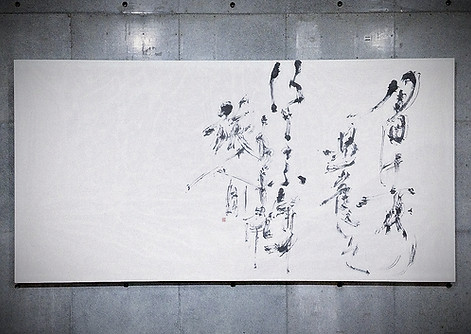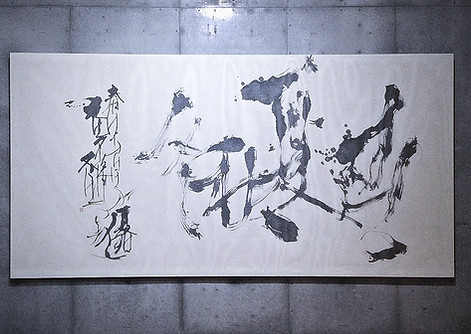
HOME > Calligraphy > Special Projects>Material Explorations
Material Explorations
The voice of calligraphy spoken through materials.
The works presented on this page represent experimental explorations of calligraphy through diverse materials. By investigating the inherent qualities of each medium, the calligraphic line acquires new expressions and possibilities. Though modest in scale, these works embody an important inquiry into the relationship between material and writing.
From the 10th Anniversary Exhibition: “Hall of Future Works” (2008)
November 2008
Tsubasa Kimura 10th Anniversary Calligraphy Exhibition
Venue: Hyogo Prefectural Museum of Art (Hyogo, Japan)
— Presented in a large-scale solo exhibition commemorating the 10th anniversary of the artist’s career.
The same motif explored across a range of materials.
Perpetual Calendar — Cover

"One, Two, Three, Four, Five, …"
Calligraphy with a bird-feather brush
Stainless Steel, Cut

"One, Two, Three, Four, Five, … (Perpetual Calendar — Cover)"
A4 size, thickness 3 mm
Aluminum Pen, Milled with 3D CAD/CAM

"Nine, Three, Thirty-Three, Thirty-One (Final Row of the Perpetual Calendar — Cover)"
Embroidery

"One, Two, Three, Four, Five, … (Perpetual Calendar — Cover)"
A4 size
Development of Hiragana
Hiragana Font Matrix

Iroha Shogi

Handmade Shogi Pieces
Materials: Urushi lacquer
Three-Dimensional Printing

"Comet"
Dimensions: H 100 cm × W 50 cm
Panel, three-dimensional special ink

"Galaxy"
Dimensions: H 100 cm × W 50 cm
Panel, three-dimensional special ink
Arita ware (porcelain), produced in Saga Prefecture, Japan

Hand-crafted Washi Series (2005)
A dialogue with washi, each sheet resonating with a different tone.
Works created with handmade washi produced by artisans across Japan, in which ink and brush were chosen to suit each paper, and the artist’s distinctive style was applied accordingly.
2005
Hand-crafted Washi Series
Venue: Transgenre, 3F Shinpukan (Kyoto, Japan)
— Presented as a concurrent project with Crowd.
The dimensions indicate the size of the honshi (the original paper of the work, excluding mounting).
“The ‘未 (Mi)’ from Mikansei (Unfinished)”
A work that isolates the character “未” (mi, meaning “not yet”) from the word mikansei (“unfinished”).

Dimensions: H 44 cm × W 55 cm
Framed
Materials: Namizuki hōsho paper (Echizen washi), handmade by Ichibei Iwano (Living National Treasure); sumi ink
A Certain One
Water Tank of Water

Dimensions: H 38.4 cm × W 54.5 cm
Framed
Materials: Sake label paper (Inshu washi), handmade by Takashi Nakahara; sumi ink

Dimensions: H 65 cm × W 25.4 cm
Framed
Materials: Misumi washi (Yoshino washi), handmade by Shoichi Kamikubo; sumi ink
The Law of the Cosmos

Urban Lines

Dimensions: H 92.7 cm × W 63 cm
Framed
Materials: Ganpi paper (Awa washi); sumi ink
Dimensions: H 137 cm × W 72 cm
Framed
Materials: Unryu paper (Inshu washi), handmade by Takashi Nakahara; sumi ink
Cognitive Dissonance

Dimensions: H 143 cm × W 31.7 cm × 2
Panel
Materials: Uda washi (Yoshino washi), handmade by Hiroyuki Fukunishi; sumi ink
The Unconscious

Dimensions: H 97 cm × W 64 cm
Panel
Materials: Reed paper (Omi washi), handmade by Tetsuro Nariko; sumi ink
Clockwork

Dimensions: H 97 cm × W 64 cm
Panel
Materials: Sun-dried kōzo paper (Kadode washi), handmade by Yasuo Kobayashi; sumi ink
Interrelation of Self and Other

Dimensions: H 134.8 cm × W 42.2 cm
Panel
Materials: Rough-fiber kōzo paper (Izumo Mingei washi), handmade by Shinichiro Abe; sumi ink
Shifu Paper + Bird-feather Brush (2011)
Selected Poems of Bird Brush
Between words and space
A series of works employing shifu, a special type of washi woven into thread-like form. Conceived to create a sense of ma, or meaningful space, within the modern architectural setting of the museum, the works resonate with their surroundings. Their subjects draw on classical poetry, haiku, and Japanese words that resound across time. Through brushes fashioned from bird feathers, these words are crystallized into calligraphy for the present day.
【Venue Photographs】


August 2006
"Selected Poems of Bird Brush"
Venue: Kaigan-dori Gallery CASO (Osaka, Japan)
Category: Re-staged presentation
— Revised into a vertical composition that made full use of the ceiling height.
[The Tale of the Heike — “Gion Shōja”]

120x240(cm)
The sound of the bell of the Gion Shōja temple
echoes the impermanence of all things.
The color of the sāla flowers
reveals the truth that the prosperous must decline.
The proud do not endure,
but vanish like a dream on a spring night.
The mighty fall at last,
resembling nothing so much
as dust before the wind.
[Matsuo Bashō — Haiku]

120x240(cm)
The early summer rains —
gathered together, they swell,
the Mogami River.
In utter silence,
the cicadas’ voices penetrate
deep into the rocks.
In the depth of autumn —
what kind of person, I wonder,
lives in the house next door?
How curious —
could it be snow, this winter rain?
[Kamo no Chōmei — Hōjōki]

120x240(cm)
*The flow of the river is ceaseless,
and yet the water is never the same.
The bubbles that float upon its surface
form and break, never lingering for long.
So it is with people and their dwellings in this world.
In the jeweled capital,
roofs stand shoulder to shoulder,
grand houses compete in splendor.
Yet if one asks whether they remain unchanged,
few are the same as in former times.
Some are destroyed by fire one year
and rebuilt the next;
some great houses decline to small ones.
It is the same with their inhabitants:
though the place remains and the people are many,
of those once known,
only one or two remain among twenty or thirty.
To die in the morning, to be born in the evening —
such is the way of the world,
like bubbles upon the water.
We do not know from where the people who are born and die come,
nor to where they go.
Why should one trouble the heart
over a temporary dwelling?
What should one rejoice in with the eyes?
Owner and house alike depart together,
subject to impermanence,
like the dewdrops upon the morning glory.
Sometimes the dew falls,
and the flower alone remains.*
[Matsuo Bashō — Oku no Hosomichi]

120x240(cm)
The passing days are eternal travelers;
the years that come and go are likewise wayfarers.
[Seasons — from The Pillow Book]

120x240(cm)
Spring — the dawn.
Summer — the night.
Autumn — the evening.
Winter — the early morning.